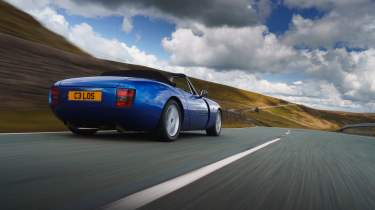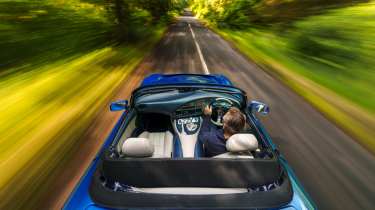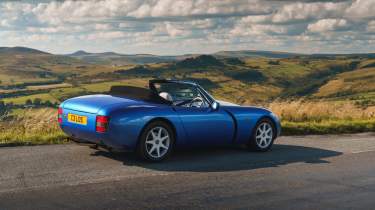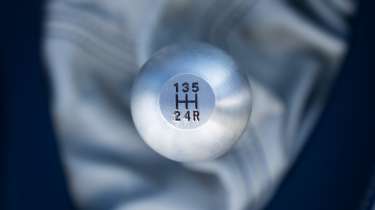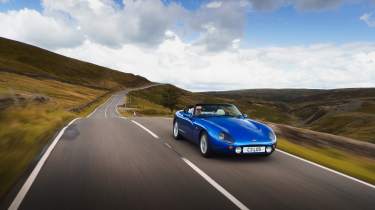TVR Griffith (1990 - 2002): a pure and unadulterated sports car
The Griffith established TVR as a genuine contender and transformed the company’s fortunes – and it’s still as exhilarating to drive now as it was in its ’90s heyday
I remember the first time I saw a TVR Griffith. It looked astounding, modern yet classic, like a traditional sports car that had been through a gemstone tumbler. It’s been years since I’ve been up close with one and as the garage door goes up, I’m in awe all over again, of the car that laid the foundations upon which the iconic TVR Sagaris and TVR Tuscan, among many others, built.
Great designs usually go through a process where they start out looking new and fresh, then become familiar and start to look a bit dated, and then, after about 20 years, they assume icon status. The Griff appears to have skipped the awkward bit in the middle and gone straight from new to icon.
In fact, I suspect that somewhere in a dusty, forgotten attic of the former TVR Engineering works on Bristol Avenue, Blackpool, is designer Damian McTaggart’s original styling sketch for the Griffith, ageing horribly; flat tyres, crusty alloys, headlamps lolling on the ends of their wires and bodywork crazed like the face of a 90-year-old Greek fisherman. The Picture of Damian’s Griff, if you will. Except that this landmark car in TVR’s history, credited to McTaggart, was a team effort, naturally involving enigmatic owner Peter Wheeler and, crucially, his right-hand man, engineer John Ravenscroft.
The owner of this gorgeous, metallic blue Griff, Carl Elston, talks me through the start procedure, and when I turn the key… Ka-Boom!, the garage, the street, the whole damn estate rocks to the rumble and woofle of the monster V8. It’s utterly glorious.
TVR reworked its engines for greater performance but in the early ’90s pretty much the whole small-volume British sports car industry was using versions of the venerable all-aluminium Rover V8, which had started life as a 3.5-litre Buick engine way back in 1960. It was still on active service in the Range Rover, creating a ready supply for TVR, Morgan, Marcos, Westfield, Ginetta and even Rover Group itself, which used it in the revived MGB, the RV8.
Some of these specialists were building cars in the same way as TVR too, so to elevate its cars beyond them, TVR needed more than a potent engine and stunning good looks. The Griffith delivered, with an interior that was as sculpted and stylish as the exterior, a genius roof design and involving dynamics.
> Lotus Emira v Morgan Plus Four – four-cylinder Brits go head-to-head
The dramatic cockpit, designed by Nick Coughlan, was wonderfully detailed, with TVR-branded dials and bespoke aluminium switches and fittings, so that it couldn’t be accused of being a parts-bin special. Even the plastic stalks of the rake-adjustable steering column (a Vauxhall part) were replaced with machined aluminium items. And while the hoods of some rivals fitted badly and ballooned and flapped at speed, the TVR’s looked crisply tailored. This was because although it looked like a soft-top it was in fact part hard-top, with a carbonfibre targa panel cleverly held in place by the tension provided by the over-centre arms of the folding rear section.
It was a decisive cut above everything else on the UK market, but TVR’s real aim was to compete with Porsche. The Griff handled well but was less sophisticated, though TVR talked up its lack of technology, claiming that the absence of anti-lock brakes and traction control delivered a purer driving experience. There was no doubt that the Griff delivered terrific and superior performance per pound, or that the company took delight in making conquest sales from Porsche. At a British motor show in the mid-’90s, TVR’s beaming PR manager gleefully revealed that they were doing great business having worked out that Porsche had given current and potential customers a lapel badge to allow them onto the Porsche stand, which of course made them easy to spot and invite onto the TVR stand…
It was quite a turnaround for the company. When Wheeler took it over in the early ’80s he inherited the wedge-shaped Tasmin range, the very models that had, in part, been the downfall of his predecessor, Martin Lilley. Wheeler had been a customer and then an investor, so it was ‘in for a penny, in for a pound’. He persisted with the Tasmins, adding the Rover V8 to the engine range to create the 350i and then, in ’86, spotting that classic sports cars were making a comeback, created his first car. The TVR S was a curvy, affordable, Ford V6-powered car not unlike the 3000M of the ’70s but in fact wore an all-new body. It was a big hit: two years after it launched, TVR sold over 500 Ss versus fewer than 200 wedges.
Among those wedges were a handful of examples of the mighty 420 SEAC. The letters stood for Special Equipment Aramid Compound, indicating that Kevlar was used in its body construction. The edges of the wedge had already been softened on the SEAC and it was only a matter of time before Wheeler would combine proper curves with V8 performance.
When the 420 SEAC was banned from the Road Going Sports Car Championship for being too successful, Wheeler and his team created the Tuscan, a 420bhp, V8, slick-shod racer for a new one-make championship, the Tuscan Challenge. There was going to be a road car too, which would have been brutishly handsome, but as John Ravenscroft explained a few years ago, we got the rather more refined Griffith instead: ‘Originally the Griff was going to be a replacement for the S and there was going to be another car, a Tuscan road car. But the Griffith sort of became that car…’
Indeed, the Griffith that wowed the crowds at the 1990 Birmingham show was built on the S chassis, but it was decided to use the beefier and bigger tubular chassis of the Tuscan racer for production. Ravenscroft was instrumental in the distinctive, smooth shape of the Griffith too. ‘Peter wanted a traditional-looking British sports car, so we did the full-scale foam model with upright headlights. I thought it was a horrible, boring, old-fashioned thing. One day I just lopped off the front of the wing where the headlight was, and that left this sort of headlight shape, and I thought, hmm, that looks nice…’
The clean line of the faired-in headlamp set the tone for the rest of the design. There were no sharp edges to the body, no swage lines, no wheelarch brows, no visible door handles, even the rear number plate was lit from the back to reduce clutter. It was clever, too, in that the leading edges of the doors and the bonnet were overlapped, giving fewer panel gaps to finesse.
The Griffith didn’t so much put TVR on the global sports car map as punch a dirty great hole through it and set fire to it on the way through. There had been significant TVRs before, but this Griffith was the key to unlocking a level of success the company had never known and that previous owners of the company had only dreamed of, paving the way for the Chimaera, which would be even more successful.
On meeting a Griffith for the first time, or again after a long time, certain things will wrong-foot you. Looking for the interior door handle, you will instinctively reach for the pop-out, half-circle ashtray on the door, forgetting that the handle is in fact by your left knee on the side of the centre console. Well, of course it is.
Owner Carl Elston has upgraded some parts on his car and refreshed others. Much of the cockpit has been retrimmed, the battery has been moved to the boot to give more space in the passenger footwell, and he’s helpfully added discreet stickers to the various hidden-till-lit buttons scattered about the sweep of facia. For good measure, he hands me the Filofax-sized handbook to help decipher what the dinky little aluminium heating and ventilation controls do. Days later, I’ll still be dropping the windows when I’m too warm.
It’s smaller than I remember (probably because all cars have got bigger in the last 30 years) and very low, so you sort of fall into the soft, narrow seats, which prove surprisingly comfortable even after hours at the wheel, with extra lateral support provided by the high centre console and door casing. Best pick your driving shoes carefully, though, because the footwell and pedals are narrow. The clutch is progressive and not too heavy, the big V8 effortlessly tractable, and the gearshift is as weighty and precise as you’d expect, given that the ‘T5’ gearbox is directly beneath the short lever. What takes me by surprise is that the non-assisted steering doesn’t lighten once you’re clear of town. Other 500s I’ve driven have had much more manageable efforts.
I’ve heard plenty of versions of the Rover V8 and still own a saucy 5.2-litre example in my Capri, but this one is pretty much spot-on for a road car. Get past the start-up boom and high idle that seem to carry for miles like the roar of a lion and the quality of the sound is wonderful right across the rev and load range. This is despite – or perhaps because of – an exhaust system that’s more stylish than functionally optimised; unequal-length headers run forward of the engine, turn 90 degrees and feed into industrial-scale, siamesed downpipes.
The V8’s heavy beat ricochets spectacularly around basement car parks and off the walls of narrow streets, yet from behind the wheel most of the time you get a muted version of that soundscape, even at full throttle, probably because you leave the noise in your wake. It’s surprisingly muted at cruising speed, too. In fact, there’s probably more wind noise from the screen header, a sort of white noise that builds at 70mph and then doesn’t seem to get much louder thereafter.
The sweet spot is full throttle in the mid-range when the note of the V8 is a delicious, smooth burr. Even pulling a high gear, it doesn’t sound like it’s working that hard to make the Griff fly, which is hardly surprising given the quoted 1060kg kerb weight. The earlier models with 4.0 and 4.3-litre V8s, tweaked to give 240 and 280bhp respectively, were less torquey and more rev happy, but I love the ever-ready, huge push of the 5-litre. You rarely feel the need to use 5000rpm, let alone 5500rpm where all 340bhp is delivered, instead relying almost entirely on the peak torque of 350lb ft, delivered at 4000rpm.
You can get into such a wonderful flow with the car on a sweeping road, joining up the curves with great gobs of torque, palming the gearlever snappily through its gate and filling the valleys with that V8 bellow. We almost didn’t get the Griffith with this engine. After the 4.0 and 4.3, the Griff was rested and was supposed to be relaunched with TVR’s own engine, the AJP8.
However, the 4.2-litre, flat-plane-crank V8 was longer in development than expected, so the 4997cc version of the Rover V8 was created and the Griffith reintroduced in ’93. Remarkably, it was still in production nine years later, and many more 5-litre engines went into Chimaeras, while the potent but rather charmless AJP8, which powered Tuscan racers from 1995, found its first and only road-car home in the Cerbera.
> Ariel Atom 4R v Caterham Seven ‘evo25’: power-to-weight heroes go head-to-head
The Griff feels comfortable with the grunt, the rear end hooked up, and there’s good grip too, even though the tyres look decidedly ordinary, almost quaint by today’s sports car standard – 205/55s up front, 245/50s at the rear. With so little weight to deal with, they put quite enough rubber on the road. Similarly, the brakes are tiny but effective. The front wheels are an inch smaller in diameter than the rears, 15 inches versus 16, yet the front discs don’t come anywhere near filling the rims. Stopping power is fine, though, and pedal feel is good too.
Traction and grip aren’t an issue then, the Griff a dream on meandering roads, the steering efforts well judged, the car precise and composed, the lack of mass and even weight distribution delivering a natural poise. This car is a bit more demanding when you want to crack on down a twisty road, the steering a workout at every corner. Perhaps it can be remedied by geometry, which might also suppress some of the ‘chatter’ and kickback on lumpy roads and unlock one of the joys of previous Griffs: steering it on the throttle, if only modestly. Or less modestly on a wet roundabout.
I once asked Wheeler where they developed the ride and handling of TVRs and he joked that at the bottom of Bristol Avenue there were a couple of bumps and potholes and if the car rode those OK it was good to go. Ride and handling is one area where the marque improved every year – the last cars of the Wheeler era, the TVR Sagaris and the TVR Tuscan road car, being the best, their ride and handling sweetly resolved. But design-wise, for me the Griffith was never topped.
There was nothing like it back in 1990 and there’s been nothing as pure and unadulterated since. The fact that it stayed in production, fundamentally the same, until 2002 I find remarkable. All that changed was the fitment of 16-inch front wheels and the replacement of the inverted Vauxhall Cavalier Mk3 tail lights with clusters of individual lamps.
The Chimaera – built around the same underpinnings – was a little more comfortable and a fraction more practical and quickly became the big-volume car, outselling the Griffith by more than two-to-one to become TVR’s best-selling model of all time. But it was the Griff that transformed TVR’s reputation, elevated the Blackpool sports car maker to the world stage and set the tone for all the models that followed. It is, in short, a solid-gold icon.
| Engine | V8, 4997cc |
|---|---|
| Power | 340bhp @ 5500rpm |
| Torque | 350lb ft @ 4000rpm |
| Weight | 1060kg |
| Power-to-weight | 326bhp/ton |
| 0-60mph | 4.1sec |
| Top speed | 169mph |
| Price new | £38,015 |
| Value today | From £18,000 |
This story was first featured in evo issue 314


